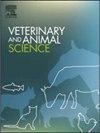Role of triptorelin and single fixed-time artificial insemination on productive and reproductive performance of hyperprolific sows
IF 1.9
Q2 AGRICULTURE, DAIRY & ANIMAL SCIENCE
引用次数: 0
Abstract
Single fixed-time artificial insemination (SFTAI) provides a streamlined approach to improving reproductive management. We evaluated the impact of incorporating triptorelin acetate (GnRH agonist) into a SFTAI protocol on a commercial farm. Hyperprolific sows not in estrus by day 4 post-weaning were randomly assigned to two groups. Group-1 (G1; n = 243) received no triptorelin treatment and daily post-cervical artificial inseminations (PCAI) based on estrus detection (2.59±0.034 inseminations/sow). Group-2 (G2; n = 249) received a single intravaginal dose of triptorelin (0.2 mg) at 96 ± 2 h post-weaning, then one PCAI 22 ± 2 h later. No significant differences (P > 0.05) between groups in conception rate (G1: 98.8 %; G2: 97.6 %), farrowing rate (G1:95.1 %; G2: 94.4 %) or litter characteristics (total born, live-, stillborn and mummified piglets). Both groups showed similar delivery batch durations (P = 0.414). Distribution of deliveries during the delivery period was similar (P = 0.455). Induction of labor was need more frequently in G1 (P < 0.001). G2 had a higher proportion of sows with shorter gestations (112–115 days: 166/235, 70.6 %) compared to G1 (112–115 days: 82/231; 35.5 %, P < 0.001). A significantly higher proportion of G2 piglets received longer lactation (27 - 33 days) compared to G1 (2210/3023=73.1 % vs 2774/4395=63.1 %; P = 0.032). G1 had a higher proportion of low-weight piglets (≤4.0 kg; 716/43950= 16.3 % vs.435/3023= 14.4 %; while G2 had more heavy piglets (≥6.5 kg; 1228/3023=40.5 % vs.1675/4395= 38.1 %) (P = 0.027). Observed differences in lactation length could be responsible for these weaning weight differences, rather than triptorelin treatment itself. This protocol did not worsen productive and reproductive performances.
雷公藤素和单次定时人工授精对高产母猪生产和繁殖性能的影响
单次定时人工授精(SFTAI)为改善生殖管理提供了一种简化的方法。我们在一个商业农场评估了将雷公藤雷素醋酸酯(GnRH激动剂)纳入SFTAI方案的影响。断奶后第4天未发情的高产母猪随机分为两组。1组(G1, n = 243)不给予雷公霉素治疗,每日根据发情检测进行宫颈后人工授精(PCAI)(2.59±0.034次授精/头)。2组(G2, n = 249)在断奶后96±2小时接受单次阴道内给药(0.2 mg), 22±2小时后接受1次PCAI。各组受胎率(G1: 98.8%; G2: 97.6%)、产仔率(G1: 95.1%; G2: 94.4%)和产仔特征(出生仔猪、活仔猪、死胎仔猪和干尸仔猪总数)均无显著差异(P > 0.05)。两组的交付批次持续时间相似(P = 0.414)。分娩期间的分娩分布相似(P = 0.455)。G1期需要引产的频率更高(P < 0.001)。G1组(112-115 d: 82/231; 35.5%, P < 0.001)较G1组(112-115 d: 82/231, P < 0.001)妊娠期较短的母猪比例较高(112-115 d: 166/235, 70.6%)。与G1相比,G2仔猪泌乳时间较长(27 - 33 d)的比例显著高于G1 (2210/3023= 73.1% vs 2774/4395= 63.1%; P = 0.032)。G1组低重仔猪比例较高(≤4.0 kg, 716/43950= 16.3% vs.435/3023= 14.4%), G2组重重仔猪比例较高(≥6.5 kg, 1228/3023= 40.5% vs.1675/4395= 38.1%) (P = 0.027)。观察到的哺乳期长度的差异可能是导致断奶体重差异的原因,而不是雷普妥林治疗本身。该方案不影响生产和繁殖性能。
本文章由计算机程序翻译,如有差异,请以英文原文为准。
求助全文
约1分钟内获得全文
求助全文
来源期刊

Veterinary and Animal Science
Veterinary-Veterinary (all)
CiteScore
3.50
自引率
0.00%
发文量
43
审稿时长
47 days
 求助内容:
求助内容: 应助结果提醒方式:
应助结果提醒方式:


